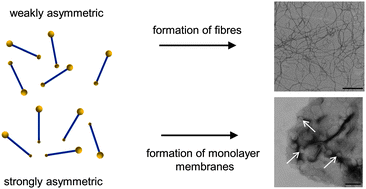Tuning the aggregation behaviour of single-chain bolaamphiphiles in aqueous suspension by changes in headgroup asymmetry†
Abstract
The self-assembly process in aqueous suspension of two new asymmetrical single-chain bolaamphiphiles, namely 32-{[hydroxy(2-hydroxyethoxy)phosphinyl]oxy}dotriacontane-1-yl-{2-[N-(3-dimethylaminopropyl)-N,N-dimethylammonio]ethylphosphate} (DMAPPC-C32-POH) and 32-hydroxydotriacontane-1-yl-{2-[N-(3-dimethylaminopropyl)-N,N-dimethylammonio]ethylphosphate} (DMAPPC-C32-OH), was studied as a function of temperature using transmission electron microscopy, differential scanning calorimetry, FT-IR-spectroscopy, small angle neutron and small angle X-ray scattering to determine whether the asymmetry of the molecule induces the formation of types of aggregates other than the well characterized helical nanofibres of structurally similar symmetrical single-chain bolaamphiphiles with identical headgroups. DMAPPC-C32-POH in acetate buffer at pH 5 can still form nanofibres, i.e. the asymmetry does not induce the formation of other aggregate structures. However, the fibres display a tendency to break more easily and to form irregular, circular structures. This is also reflected by the rheological properties of the suspension that reveal decreased strain resistance at pH 5. In aqueous suspensions at pH 10, where the headgroups of the molecule are negatively charged, only short fibre segments are formed and no gel formation occurs. At higher temperature these fibres convert into micellar aggregates as observed before for symmetrical bolalipids with large headgroups. In contrast, in aqueous suspensions of DMAPPC-C32-OH, a bolalipid where the size difference of the headgroups is much larger, lamellar structures are formed at pH 10 where the headgroup of the molecule is zwitterionic. At low temperature, the molecules are packed in an orthorhombic lattice with interdigitated chains and a repeat distance between lamellae of 6.2 nm is observed. An increase in temperature leads to a lamellar phase with hexagonal packing of the chains. The chains become liquid-crystalline only at very high temperature above 90 °C. At low pH, when the headgroup of the molecule becomes positively charged, some short elongated micellar aggregates are seen besides sheet-like structures. A temperature increase leads to a similar sequence of transformations of the chain packing until formation of a liquid-crystalline lamellar phase at a temperature close to 90 °C. The results show that the aggregation behaviour of single-chain bolaamphiphiles can not only be tuned by changes in chain length or size of both headgroups but also by the difference in headgroup size and charge in asymmetric bolaamphiphiles.


 Please wait while we load your content...
Please wait while we load your content...